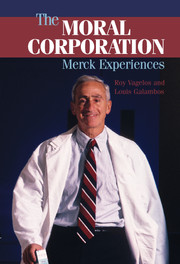4 - New Drugs and Public Safety
Published online by Cambridge University Press: 05 June 2012
Summary
Since the real test of my leadership in research was the program in cardiovascular disease, Al Alberts, Art Patchett, and their research teams were on center stage at MRL. Patchett was working on hypertension and Alberts was trying to discover a drug that would safely lower cholesterol levels.1 Both teams were using the new strategy of drug discovery, so I had a big investment in their research, as did the millions of people suffering from heart disease.
After Al and I had reviewed the literature on cholesterol research, we had quickly decided that he and his coworkers should target the rate-limiting enzyme in the biosynthesis of cholesterol.2 It was less clear how to proceed from that point, but we sought leads from two sources. One was the library of compounds that Merck chemists had developed over many years and could tap for this specific purpose. The other was nature.
On the nature path, we were able to get help from Art Patchett and our microbiologists who could employ a technology they had devised to screen soil microorganisms from various parts of the world. They isolated the microorganisms and grew them in small cultures in the laboratory and then in larger fermentation broths. The resulting broth was extracted to separate any interesting microbial products for testing. These cultures were a potential source of the molecule Al Alberts needed.
- Type
- Chapter
- Information
- The Moral CorporationMerck Experiences, pp. 49 - 74Publisher: Cambridge University PressPrint publication year: 2006



